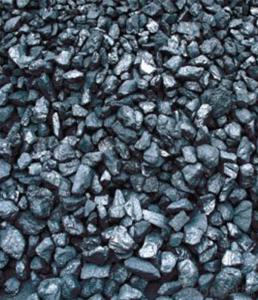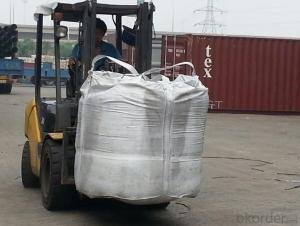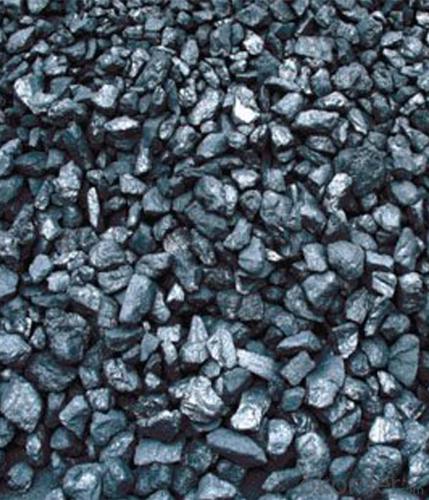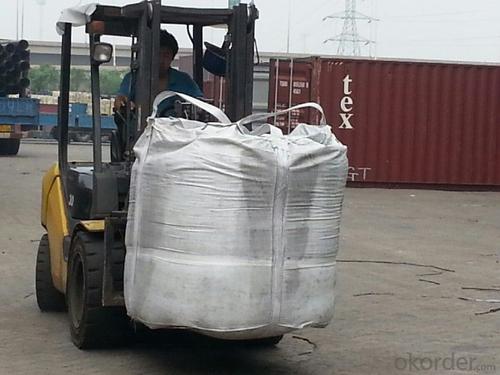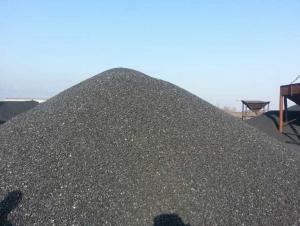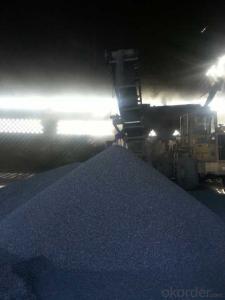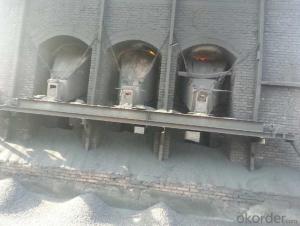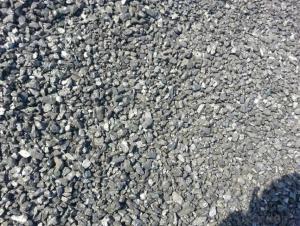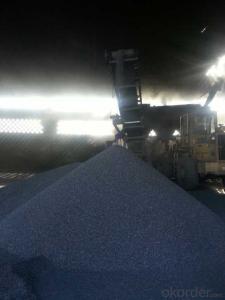Carbon Additive FC80-90 with stable quality
- Loading Port:
- Tianjin
- Payment Terms:
- TT OR LC
- Min Order Qty:
- 20 m.t.
- Supply Capability:
- 3000 m.t./month
OKorder Service Pledge
OKorder Financial Service
You Might Also Like
Packaging & Delivery
25kgs/50kgs/1ton per bag or as buyer's request
Specifications
Calcined Anthracite
Fixed carbon: 90%-95%
S: 0.5% max
Size: 0-3. 3-5.3-15 or as request
It used the high quality anthracite as raw materials through high temperature calcined at over 2000 by the DC electric calciner with results in eliminating the moisture and volatile matter from anthracite efficiently, improving the density and the electric conductivity and strengthening the mechanical strength and anti-oxidation. It has good characteristics with low ash, low resistvity, low sulphur, high carbon and high density. It is the best material for high quality carbon products.
Advantage and competitive of caclined anthracite:
1. strong supply capability
2. fast transportation
3. lower and reasonable price for your reference
4.low sulphur, low ash
5.fixed carbon:95% -90%
6..sulphur:lower than 0.3%
General Specification of Calcined Anthracite:
| FC | 80 | 83 | 85 | 88 | 90 |
| ASH | 16 | 14 | 13 | 10 | 8.5 |
| V.M. | 3 | 3 | 2 | 2 | 1.5 |
| S | 0.5 | 0.5 | 0.5 | 0.5 | 0.35 |
| MOISTURE | 2 | 2 | 1 | 1 | 0.5 |
Pictures
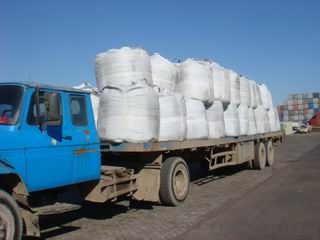
We are also strong at below materials, please contact us if you are interested in any of them:
Calcined Petroleum Coke
Carbon Electrode Paste
Carbon Electrode
- Q: How does carbon affect the formation of droughts?
- Carbon dioxide (CO2) and other greenhouse gases play a significant role in the formation of droughts. The increase in carbon emissions from human activities, such as burning fossil fuels and deforestation, has led to a rise in atmospheric CO2 concentrations. This increase in CO2 acts as a heat-trapping blanket, causing the Earth's average temperature to rise, a phenomenon known as global warming. Global warming intensifies the hydrological cycle, which is the process of evaporation, condensation, and precipitation that regulates the availability of water on Earth. As the atmosphere becomes warmer, evaporation rates increase, leading to more moisture being stored in the air. This increased moisture content can result in more intense rainfall events and potentially severe storms in certain regions. However, while there may be an increase in extreme rainfall events, global warming also leads to a reduction in overall precipitation in many areas. Higher temperatures cause increased evaporation from soil, lakes, and rivers, which depletes available water sources. As a result, droughts become more frequent and severe. Additionally, the warming climate alters the patterns of atmospheric circulation, such as the jet stream, which influences weather systems. These changes can result in shifts in precipitation patterns, causing more regions to experience prolonged dry spells and exacerbating the risk of drought. Furthermore, the impacts of carbon emissions and global warming extend beyond the direct effects on precipitation. Rising temperatures also accelerate the rate of evapotranspiration, the process by which water is transferred from the land to the atmosphere through evaporation from the soil and transpiration from plants. This increased evapotranspiration leads to higher water demand from vegetation and crops, which can further contribute to water scarcity and drought conditions. In conclusion, carbon emissions and the resulting global warming significantly affect the formation of droughts. The rise in CO2 concentrations traps heat in the atmosphere, leading to increased evaporation rates, altered atmospheric circulation, and shifts in precipitation patterns. These factors, combined with higher rates of evapotranspiration, result in more frequent and severe droughts. Addressing carbon emissions and mitigating climate change are crucial steps in reducing the risk and impact of droughts in the future.
- Q: What are the advantages of carbon-based fertilizers?
- There are several advantages of carbon-based fertilizers that make them a popular choice among farmers and gardeners. Firstly, carbon-based fertilizers such as compost and manure are organic in nature, which means they are derived from natural sources and do not contain synthetic chemicals. This makes them environmentally friendly and reduces the risk of water pollution or soil degradation. Secondly, carbon-based fertilizers are rich in organic matter, which improves the soil structure and enhances its ability to retain water. This can be particularly beneficial in areas with low soil fertility or frequent droughts, as it helps to conserve moisture and prevent nutrient leaching. Furthermore, carbon-based fertilizers promote the growth of beneficial microorganisms in the soil. These microorganisms break down organic matter and release essential nutrients in a slow and gradual manner, ensuring a steady supply of nutrients to the plants. This improves overall plant health and reduces the risk of nutrient imbalances or deficiencies. Additionally, carbon-based fertilizers are cost-effective in the long run. While they may require more initial effort and time to produce or source, they can be produced on-site through composting or obtained from local sources such as farms or livestock operations. This reduces the need for expensive chemical fertilizers and minimizes transportation costs. Lastly, carbon-based fertilizers contribute to carbon sequestration and help combat climate change. By using organic waste materials as fertilizers, we divert them from landfills where they would emit greenhouse gases. Instead, they are recycled back into the soil, increasing its carbon content and promoting soil health. Overall, carbon-based fertilizers offer numerous advantages in terms of sustainability, soil fertility, cost-effectiveness, and environmental impact. Their use can contribute to healthier plants, improved soil quality, and a more sustainable and resilient agricultural system.
- Q: Want advanced reinforcement, but I do not know where the high furnace rock carbon, looking for someone to guide...
- Before the mall has sold, now you can see
- Q: What are greenhouse gases?
- Greenhouse gases are gases that trap heat in the Earth's atmosphere, contributing to the greenhouse effect. They include carbon dioxide (CO2), methane (CH4), nitrous oxide (N2O), and fluorinated gases. These gases are naturally occurring and are also emitted through human activities such as burning fossil fuels, deforestation, and industrial processes. The greenhouse effect is vital for life on Earth as it helps to keep the planet warm enough to support life. However, excessive emissions of greenhouse gases have caused an imbalance in the atmosphere, leading to global warming and climate change. It is important to reduce greenhouse gas emissions and find sustainable alternatives to mitigate the impacts of these gases on our planet.
- Q: How to identify a laptop shell is carbon fiber
- Carbon fiber, as its name suggests, is made from carbon fiber, so there are several characteristics. First, if it is not colored, you can see the obvious fiber. Second is black carbon color. And it's a lot more than ABS.
- Q: What are the advantages of carbon-based solar cells?
- Carbon-based solar cells possess numerous advantages that make them an encouraging technology for the production of renewable energy. To begin with, their lightweight and flexible nature imbue them with high versatility, enabling deployment in a variety of ways. They can be seamlessly integrated into surfaces such as building facades, windows, and even garments, thereby expanding the potential for solar energy generation. Furthermore, carbon-based solar cells boast a minimal environmental impact compared to their silicon-based counterparts. The manufacturing process for carbon-based solar cells typically entails lower energy consumption and the use of fewer toxic materials, thus reducing the overall carbon footprint of the technology. Moreover, they possess a shorter energy payback time, surpassing the point at which they generate more energy than is required for their production at a faster rate than silicon-based solar cells. Another advantage lies in the potential for low-cost manufacturing of carbon-based solar cells. Carbon-based materials such as organic polymers or perovskites can be produced using cost-effective techniques like solution processing or printing methods. This scalability and affordability render carbon-based solar cells an appealing choice for large-scale deployment, thereby expediting the global adoption of solar energy. Additionally, carbon-based solar cells exhibit the potential for enhanced performance in low-light conditions. By virtue of their unique properties, including the ability to absorb a broader spectrum of light wavelengths, they are capable of generating electricity even in overcast or indoor environments. Consequently, carbon-based solar cells find applicability in a wider array of contexts, encompassing indoor electronics, wearable devices, and integration into urban infrastructure. Lastly, the biodegradable nature of certain carbon-based materials employed in solar cells renders them more environmentally friendly. As the world progresses towards a circular economy and endeavors to implement sustainable solutions, the capacity to recycle or dispose of solar cells without causing harm to the environment assumes increasing significance. In conclusion, carbon-based solar cells offer a range of advantages, such as flexibility, minimal environmental impact, low-cost manufacturing, enhanced performance in low-light conditions, and biodegradability. These advantages position them as a promising technology for realizing a sustainable and universally accessible future powered by solar energy.
- Q: What are the consequences of increased carbon emissions on vulnerable communities?
- Increased carbon emissions have severe consequences on vulnerable communities. These communities, often located in low-income areas or developing countries, bear the brunt of climate change impacts such as extreme weather events, rising sea levels, and reduced access to resources like clean water and food. These consequences exacerbate existing social and economic inequalities, leading to displacement, loss of livelihoods, increased health risks, and even conflicts over scarce resources. It is crucial to address carbon emissions and support these communities to build resilience and adapt to the changing climate.
- Q: How is carbon used in the production of paints and pigments?
- Due to its unique properties and versatility, carbon finds wide application in the production of paints and pigments. A primary utilization of carbon is seen in the production of carbon black, which is a fine powder derived from the incomplete combustion of hydrocarbons like coal tar, petroleum, or natural gas. Carbon black proves highly useful as a pigment in various paints, inks, and coatings. The deep shade of carbon black makes it a popular choice for creating intense black pigmentation in paints and pigments. Its exceptional stability and resistance to fading ensure the color remains vibrant over time. Furthermore, carbon black exhibits excellent opacity, effectively covering other colors and providing a solid foundation for further pigmentation. In addition to its role as a pigment, carbon black enhances the durability and performance of paints and coatings. It acts as a reinforcing agent, elevating the mechanical properties of the final product. By increasing strength, toughness, and resistance to abrasion, carbon black ensures the paint or coating is long-lasting and resistant to wear and tear. Moreover, carbon black possesses electrical conductivity, making it a valuable component in specialty coatings, including anti-static coatings and electromagnetic shielding coatings. These coatings are critical in industries such as electronics, automotive, and aerospace, where electrical conductivity or protection against electromagnetic interference is essential. Besides carbon black, other forms of carbon, such as graphite and carbon nanotubes, find application in the production of specialized paints and pigments. Graphite is commonly utilized in high-performance coatings due to its lubricating properties and resistance to extreme temperatures. On the other hand, carbon nanotubes offer unique optical, electrical, and mechanical properties, making them suitable for advanced coatings and pigments in various applications. In conclusion, carbon plays a vital role in the production of paints and pigments by providing intense black pigmentation, enhancing durability, and offering unique properties for specialized coatings. Its versatility as an ingredient ensures the production of high-quality, long-lasting, and visually appealing products in the paint and pigment industry.
- Q: Does anyone know what the definition of carbon storage is in ecology? Thank you
- It's not 12g's problem, it's carbon selection.If oxygen is selected, it is not 12g, but it must be 16g.So why choose carbon atoms instead of other atoms?(Note: this carbon atom must have 6 protons and 6 neutrons. The following is called C-12. Of course, there are 6 protons and 7 neutrons, or 8 neutrons carbon atoms, but can not be usedI refer to other information stored on the computer, but I can't remember the source.The reason why C-12 is used as the relative atomic mass standards are as follows: (1) the formation of many high quality carbon molecular ion and hydride, for mass spectrometry; (2) 12C is easily measured in a mass spectrometer, using mass spectrometer to determine the relative atomic mass is the most accurate method of modern (3); after using C-12, the relative atomic mass of all elements have little change, only 0.0043% less than in the past; (4) the carbon atom is stable in natural abundance; (5) the carbon in nature is widely distributed and its compounds especially organic compounds is various; (6) the minimum density of hydrogen is relative atomic mass not less than 1.The absolute mass of an atom is very small, and if expressed in kilograms, it is very inconvenient. Thus, 1/12, the quality of such a carbon atom, is used as a standard, and the mass of other atoms is the relative atomic mass of this atom
- Q: How does carbon impact the melting of polar ice caps?
- Carbon impacts the melting of polar ice caps primarily through climate change. Carbon dioxide (CO2) is a greenhouse gas that traps heat in the atmosphere, causing the Earth's temperature to rise. This increase in temperature leads to the melting of polar ice caps. When carbon is released into the atmosphere through human activities such as burning fossil fuels, deforestation, and industrial processes, it accumulates and contributes to the greenhouse effect. As the concentration of CO2 increases, more heat is trapped, resulting in the warming of the planet. Polar ice caps, especially in the Arctic and Antarctica, are particularly vulnerable to this warming. The melting of the ice caps is accelerated by rising temperatures, causing them to shrink and eventually collapse. This process is known as ice cap retreat. The impact of carbon on polar ice caps is twofold. Firstly, the melting of ice caps contributes to sea-level rise, which poses a significant threat to coastal communities and low-lying areas worldwide. As the ice caps melt, the water from them flows into the oceans, causing them to expand. This can lead to coastal erosion, increased flooding, and the loss of valuable habitats and ecosystems. Secondly, the melting of polar ice caps also disrupts the delicate balance of the Earth's climate system. The reflective surface of ice helps to regulate the planet's temperature by reflecting sunlight back into space. As the ice melts, it is replaced by darker surfaces such as water or land, which absorb more heat. This further exacerbates global warming, creating a feedback loop that accelerates the melting process. Overall, the impact of carbon on the melting of polar ice caps is profound. The continued release of carbon into the atmosphere is contributing to the loss of these critical ecosystems, causing sea-level rise, and disrupting the Earth's climate system. To mitigate these effects, it is crucial to reduce carbon emissions and transition to cleaner and more sustainable sources of energy.
Send your message to us
Carbon Additive FC80-90 with stable quality
- Loading Port:
- Tianjin
- Payment Terms:
- TT OR LC
- Min Order Qty:
- 20 m.t.
- Supply Capability:
- 3000 m.t./month
OKorder Service Pledge
OKorder Financial Service
Similar products
Hot products
Hot Searches
Related keywords
